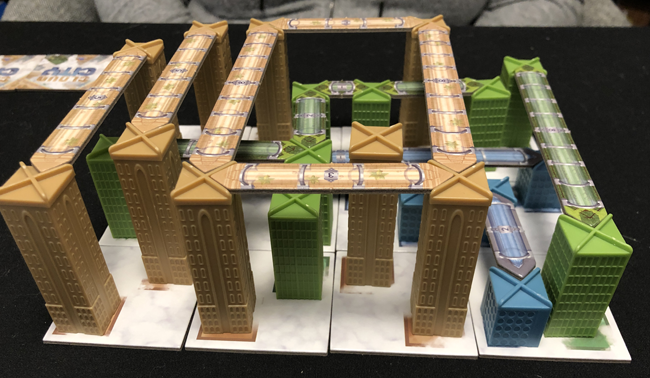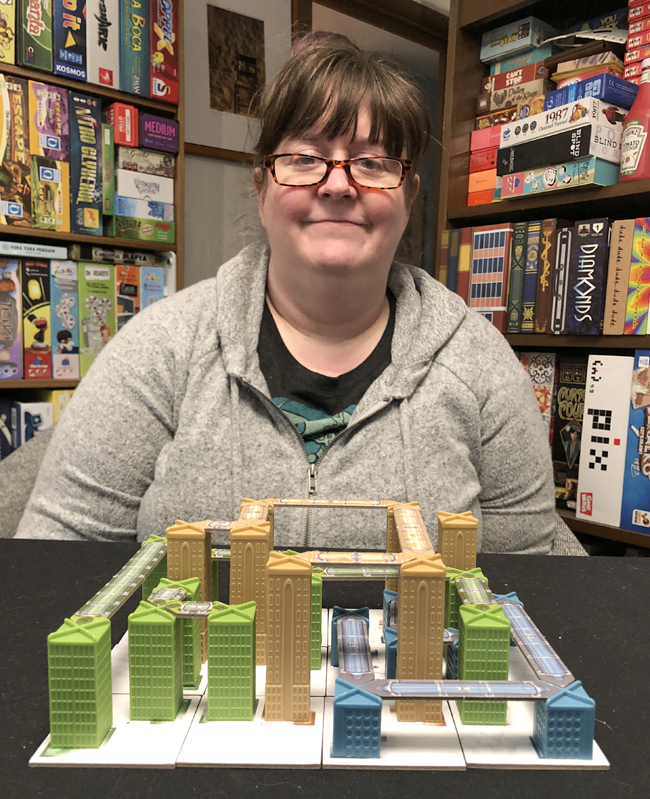
Cloud City
Official Site | BGG | Buy
Designer: Phil Walker-Harding
Artist: Fabrice ROS
Publisher: Blue Orange Games
2-4 players 30 minutes ages 10+ MSRP $35
Time to teach & learn: 3 minutes

You are an architect creating a layout for a network of interconnected skyscrapers. Up and up, higher and higher, the city rises! The City Council will select only one architect’s plan – the most ambitious expansion will gather the most votes and become a blueprint for your very own city in the clouds!

Houses have curb appeal. Games have table presence. Cloud City’s 3-D elements are fun and engaging and will draw attention whenever it is played.
There are 96 plastic buildings split evenly between 3 different colors: green, blue and sandy brown. All buildings of a single color are also a single height. Sandy buildings are the tallest, green buildings are medium, and blue are the shortest.
Each color building has a set of 31 matching walkways. The walkways come in 5 different lengths.




48 square city tiles depict different configurations of colored buildings rising above the clouds. Each tile is split into four grid squares and each tile has a mix of two open cloud spaces and two spaces with a green, blue, or sand colored building.
There are also some start tiles, one for each player and some special request cards that add more scoring options.
To play, each player takes a start tile and places matching colored buildings on the corresponding spaces shown on the tile. The remaining city tiles are shuffled and each player receives a hand of three tiles. Three tiles are also flipped face-up for all to see. Give yourself enough room on the table to build around, since your city is about to expand!

Cloud City is a game about building bridges. The more bridges and the longer bridges you can construct to connect buildings of similar height, the more votes you will secure from the City Council. The most votes wins the game.
The game is played over 8 turns with 4 players or 11 turns with 2 or 3 players.
At the end of a four player game, your city will be a square – a 3 by 3 grid of 9 city tiles with buildings rising from each tile and bridges connecting some.
At the end of a 2 or 3 player game, your city will be a rectangle – either a 3 by 4 or a 4 by 3 grid of city tiles, again with buildings and connecting bridges.
Each turn in the game you will do two things and have an option for a third.
You will pick one tile from your hand and add it to your city.
You will place matching colored 3-D buildings on the corresponding colored spaces on the tile.


Last but not least, you now have the option to build bridges between buildings.
The bridges come in five different sizes spanning 1,2,3,5 or 8 spaces. The top of each building is made in such a way that the point of each bridge will nestle down snugly into the roof.
There are a few restrictions to keep in mind when building each bridge.
A bridge can only connect buildings of the same color/height (always a flat walkway – never any ramps).
A bridge cannot pass over an open area without a city tile under it.
A bridge cannot cross over a building of the same color/height.
A bridge cannot lay across another bridge of the same color/ height.
And last but not least, each building may only have two bridges connected to it.
You are welcome to build as many bridges as you like on a given turn, provided you follow these restrictions.
That said, you are never obligated to build a bridge. You always have the option to wait and build on a later turn.


After playing a tile, placing buildings, and deciding whether to build bridges, you draw a new city tile into your hand either from the face up row of city tiles or the top face down tile from the draw pile.
Play continues until each player’s city is complete (9 tiles in a 4 player game, 12 tiles in a 2 or 3 player game).
Scoring is simple. Each bridge has a number of points listed on it. Add up all the points on the bridges you have built. This is the number of votes you receive. Most votes wins the game.

Each choice allows your city to expand – every new tile offers new buildings and possible connections. But each choice also begins to set the boundaries for your city – giving shape and limits to what you will be able to build in just a few short turns. This means you have to have pay attention to how your city expands and contracts with every choice you make.
You have to consider how to line up like colored buildings in order to build bridges. Small connections are easier to line up, but they yield fewer points. In order to leave large gaps open for longer bridges to be built, you will most likely have to focus on one specific level and not try to optimize every possible path. The pressure of building in such a small area makes every choice in the game meaningful, challenging, and fun.
Something as simple as the layout of the colored buildings on each tile in your hand becomes extremely important when considering how to keep each level on your city open for longer bridges and higher scores.

This makes the choice of what tile to take at the end of each turn significant. If you don’t think ahead to your needs beyond the current bridge, your city will fill up and leave you with buildings in the way, preventing longer bridges.
What tile to place is important, but when to place bridges is just as critical. Early on, you can bank on points by connecting smaller, obvious paths. But there’s also risk involved. Because each building can only have two bridge connections, you might close off larger scoring potentials. Wait too long, though, and another building might go up, blocking your path.

And even when things don’t go according to plan, the game goes so quickly, you’ll be left wanting to try again and make better choices next time. Cloud City condenses the quiet, contemplative fun of a much longer and more involved game into a brief encounter. A short story instead of a novel. No less moving or interesting for its brevity, but certainly more accessible.

Cloud City is Major Fun because it is condensed, refined. Play a tile, place buildings, build bridges – rules easy enough for players from mid elementary age to retirement to grok the basics and learn by doing.
It is also hard to overstate the powerful draw of creating a 3-D map of your own to marvel at when the game is done. Your choices make something to be admired and studied whether you win or lose.

Cloud City earns our Spiel of Approval because it offers an even deeper level of strategy and gameplay through the addition of special request cards.
These cards provide additional ways to score.
Some cards deal with bridges: points for building many separate paths, or closed loops, or a path with the highest total value.
Other cards focus on buildings: points for building the most of a given color, or the most buildings with a single bridge connection.
There are even request cards that take points away! Negative points for crossed bridges or freestanding buildings without any bridges at all.
The rules and flow of the game remain completely unchanged – but the goals you strive for and HOW you play each turn make the game completely new and different.

The suggestion in the rules is to play with two request cards at a time. We could not resist adding more request cards to our games until eventually we were playing with every request card and every new scoring rule in effect. You will want to work up to this level, but in just a few games, my guess is you will want to take on the challenge of scoring as many possible ways as you can within the same pressure packed small set of turns.
Does the Cloud City need these extra layers to be enjoyable? Not at all.
The game is open to such a wide range of players and experience levels – this makes Cloud City a lovely introduction to the quiet fun that is possible through strategic thinking and thoughtful play.
Does Cloud City benefit from having these advanced options available? Absolutely!
The game itself builds bridges to deeper and more nuanced decisions without adding complexity. Each decision has more consequences to predict, making for a greater challenge to assemble a winning plan.
Most of the time, a player must move on from an open and accessible strategy game to find an experience with more layers and depth. It’s a remarkable achievement for Cloud City to house both in one box.
No matter what level of strategy you enjoy, there’s a simple, beautiful elegance to the dance your mind does when you play Cloud City. There are so few turns in each game, every one matters in surprising and fun ways. We don’t need to build this game up. Cloud City, for all its headiness, has set down deep roots in Major Fun.
***
Written by: Stephen Conway

